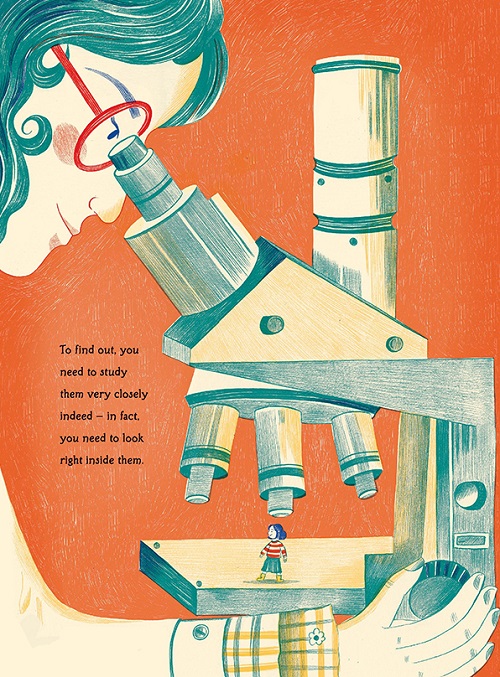Nano: The Spectacular Science of the Very (Very) Small
 October 5th, 2021 by jules
October 5th, 2021 by jules
Dr. Jess Wade’s debut picture book — Nano: The Spectacular Science of the Very (Very) Small (Candlewick, September 2021), illustrated by Melissa Castrillón — is an exploration of the building blocks of all things (atoms, elements); how those small things are used in the field of nanotechnology; and how nanomaterials of today can result in a more environmentally-friendly world. Wade is an award-winning physicist, activist, and science communicator, living in the UK. She works very hard (please read this Q&A) to ensure that the contributions of underrepresented researchers, especially women scientists, are not overlooked.
Wade’s engaging introduction asks young readers to consider the things in their home and what they are made of, thereby introducing them to the concept of materials, atoms, and molecules. This leads to a discussion about the most common elements in the human body; carbon; graphite; and graphene. Graphene is a nanomaterial, we read, and “nanomaterials are AMAZING!” We are already using nanomaterials, we also read, to make things like lighter airplanes that require less fuel, windowpanes that wash themsleves using sunlight, lighter phones, and medicines that doctors can “steer through your body so that they end up in exactly the right place.” Best of all …
There’s plenty more in store. Scientists are working to make sieves with nanosize holes, small enough to trap even the tiniest specks of salt and dirt. These super-sieves could make seawater safe to drink — which could help millions of people in need of clean water.
(This spread is pictured below.)
And there are more improvements to this battered world that physicists are using nanotechnology to explore, but I’ll leave that for you to discover when you read this informative and magnificent book.
Wade has a passion and reverence for the subject matter that shines. And she never speaks down to children, reminding them in the end that it might just be “YOU,” the reader, who unlocks more secrets of nanotechnology.
Castrillón’s elegant, fine-lined illustrations feature a pleasing palette of forest-greens, dark roses, sapphire blues, and silky creams. The illustrations depict a curious girl exploring her world, and we see (not surprisingly, given Wade’s activisim) female scientists (or budding scientists) hard at work in more than one spread. One beautifully conceived spread (one of many) shows a blind girl in profile. A diagram that points to her glasses conceptually describes how a nanochip would work, one that would connect to a pair of video glasses. Behind her head, pictured on the recto, is part of our globe with people from all over the world sending pictures via a computer, since the glasses would “send the person pictures of the world around them!” It’s eye-catching compositions like these that make this inviting book even more appealing.
The book’s aftermatter includes more information about nanoscience, chemists, physicists, engineers, and microscopes.
Dr. Wade is a force of nature, and I hope she has more picture books in her. Here are some spreads. …



which could help millions of people in need of clean water.”
(Click spread to enlarge)
NANO: THE SPECTACULAR SCIENCE OF THE VERY (VERY) SMALL. Text copyright © 2021 by Jess Wade. Illustrations copyright © 2021 by Melissa Castrillón and reproduced by permission of the publisher, Candlewick Press, Somerville, MA.

